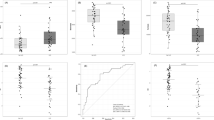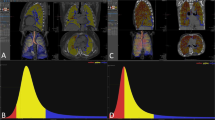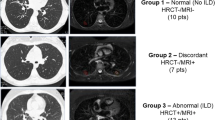Abstract
Objectives
To compare the previously defined six different histogram-based quantitative lung assessment (QLA) methods on high-resolution CT (HRCT) in patients with systemic sclerosis (SSc)–related interstitial lung disease (ILD).
Methods
The HRCT images of SSc patients with ILD were reviewed, and the visual ILD score (semiquantitative) and the severity of ILD (limited or extensive) were calculated. The QLA score of ILD was evaluated using the previously defined six different methods and parameters (different lung attenuation ranges, skewness, kurtosis, mean lung attenuation, and standard deviation [SD]). Pulmonary function tests (PFTs) were also performed on all patients. Relationships among variables were evaluated using Spearman’s correlation coefficient (r). Diagnostic performance of quantitative methods for the ability to differentiate the limited from extensive ILD was calculated using ROC analysis.
Results
Fifty-five patients were included in the study. There was a significant correlation between all quantitative and semiquantitative measurement results (p < 0.0001). The QLA scores revealed a significant correlation with PFT results. The kurtosis value of the voxels between − 200 and − 1024 Hounsfield unit (HU) (Method-5) showed the best correlation with semiquantitative evaluation (r = − 0.740, p < 0.0001). The ROC analysis demonstrated the best performance of SD of the voxels between − 400 and − 950 HU (Method-6) for histogram analysis method and Method-3 (voxels between − 260 and − 600 HU were calculated as ILD) for CT density cutoff methods.
Conclusions
All the QLA methods are applicable in assessing the ILD score in SSc patients and have potential importance to differentiate limited from extensive ILD.
Key Points
• Quantitative interstitial lung disease assessment helps clinicians to assess systemic sclerosis patients with interstitial lung disease.
• Quantitative lung assessment methods are applicable in assessing the interstitial lung disease score in systemic sclerosis patients.
• Quantitative lung assessment methods have potential importance in the management of patients.





Similar content being viewed by others
Abbreviations
- AUC:
-
Area under the curve
- CII:
-
Computerized integrated index
- CII-5:
-
Computerized integrated index of Method-5
- CII-6:
-
Computerized integrated index of Method-6
- CT:
-
Computed tomography
- CVDs:
-
Collagen vascular diseases
- DLCO:
-
Single-breath diffusing capacity
- DcSSc:
-
Diffuse forms of systemic sclerosis
- FEV1:
-
Forced expiratory volume in 1 s
- FVC:
-
Forced vital capacity
- HRCT:
-
High-resolution computed tomography
- HU:
-
Hounsfield unit
- ILD:
-
Interstitial lung disease
- KURT-5:
-
Kurtosis value of Method-5
- KURT-6:
-
Kurtosis value of Method-6
- LcSSc:
-
Limited forms of systemic sclerosis
- MLA:
-
Mean lung attenuation
- MLA-5:
-
Mean lung attenuation value of Method-5
- MLA-6:
-
Mean lung attenuation value of Method-6
- PCA:
-
Principal component analysis
- PFT:
-
Pulmonary function test
- PRoTA:
-
Pattern recognition or texture analysis
- QLA:
-
Quantitative lung assessment
- QUANT-1:
-
Quantitative Method-1
- QUANT-2:
-
Quantitative Method-2
- QUANT-3:
-
Quantitative Method-3
- QUANT-4:
-
Quantitative Method-4
- ROC:
-
Receiver operating characteristic
- SD:
-
Standard deviation
- SD-5:
-
Standard deviation value of Method-5
- SD-6:
-
Standard deviation value of Method-6
- SKEW-5:
-
Skewness value of Method-5
- SKEW-6:
-
Skewness value of Method-6
- SSc:
-
Systemic sclerosis
- TLC:
-
Total lung capacity
References
Walker UA, Tyndall A, Czirjak L et al (2007) Clinical risk assessment of organ manifestations in systemic sclerosis: a report from the EULAR Scleroderma Trials and Research group database. Ann Rheum Dis 66:754–763
Steen VD, Medsger TA (2007) Changes in causes of death in systemic sclerosis, 1972-2002. Ann Rheum Dis 66:940–944
Ioannidis JP, Vlachoyiannopoulos PG, Haidich AB et al (2005) Mortality in systemic sclerosis: an international meta-analysis of individual patient data. Am J Med 118:2–10
Mouthon L, Berezné A, Brauner M, Kambouchner M, Guillevin L, Valeyre D (2007) Pneumopathie infiltrante diffuse de la sclerodermie systemique [Interstitial lung disease in systemic sclerosis]. Rev Mal Respir 24:1035–1046
Caron M, Hoa S, Hudson M, Schwartzman K, Steele R (2018) Pulmonary function tests as outcomes for systemic sclerosis interstitial lung disease. Eur Respir Rev 27:170102
Watadani T, Sakai F, Johkoh T et al (2013) Interobserver variability in the CT assessment of honeycombing in the lungs. Radiology 266:936–944
Aziz ZA, Wells AU, Hansell DM et al (2004) HRCT diagnosis of diffuse parenchymal lung disease: inter-observer variation. Thorax 59:506–511
Ninaber MK, Stolk J, Smit J et al (2015) Lung structure and function relation in systemic sclerosis: application of lung densitometry. Eur J Radiol 84:975–979
Yabuuchi H, Matsuo Y, Tsukamoto H et al (2014) Evaluation of the extent of ground-glass opacity on high-resolution CT in patients with interstitial pneumonia associated with systemic sclerosis: comparison between quantitative and qualitative analysis. Clin Radiol 69:758–764
Salaffi F, Carotti M, Bosello S et al (2015) Computer-aided quantification of interstitial lung disease from high resolution computed tomography images in systemic sclerosis: correlation with visual reader-based score and physiologic tests. Biomed Res Int 2015:834262
Salaffi F, Carotti M, Di Donato E, Di Carlo M, Ceccarelli L, Giuseppetti G (2016) Computer-aided tomographic analysis of interstitial lung disease (ILD) in patients with systemic sclerosis (SSc). Correlation with pulmonary physiologic tests and patient-centred measures of perceived dyspnea and functional disability. PLoS One 11:e0149240
Marten K, Dicken V, Kneitz C et al (2009) Interstitial lung disease associated with collagen vascular disorders: disease quantification using a computer-aided diagnosis tool. Eur Radiol 19:324–332
Marten K, Dicken V, Kneitz C et al (2009) Computer-assisted quantification of interstitial lung disease associated with rheumatoid arthritis: preliminary technical validation. Eur J Radiol 72:278–283
Çetinçakmak MG, Göya C, Hamidi C et al (2016) Quantitative volumetric assessment of pulmonary involvement in patients with systemic sclerosis. Quant Imaging Med Surg 6:50–56
Ariani A, Silva M, Bravi E et al (2015) Operator-independent quantitative chest computed tomography versus standard assessment of interstitial lung disease related to systemic sclerosis: a multi-centric study. Mod Rheumatol 25:724–730
Ariani A, Lumetti F, Silva M et al (2014) Systemic sclerosis interstitial lung disease evaluation: comparison between semiquantitative and quantitative computed tomography assessments. J Biol Regul Homeost Agents 28:507–513
Camiciottoli G, Orlandi I, Bartolucci M et al (2007) Lung CT densitometry in systemic sclerosis: correlation with lung function, exercise testing, and quality of life. Chest 131:672–681
Koyama H, Ohno Y, Yamazaki Y et al (2010) Quantitatively assessed CT imaging measures of pulmonary interstitial pneumonia: effects of reconstruction algorithms on histogram parameters. Eur J Radiol 74:142–146
Kazantzi A, Costaridou L, Skiadopoulos S et al (2014) Automated 3D ιnterstitial lung disease extent quantification: performance evaluation and correlation to PFTs. J Digit Imaging 27:380–391
Kim HJ, Brown MS, Elashoff R et al (2011) Quantitative texture-based assessment of one-year changes in fibrotic reticular patterns on HRCT in scleroderma lung disease treated with oral cyclophosphamide. Eur Radiol 21:2455–2465
Kim HJ, Tashkin DP, Gjertson DW et al (2016) Transitions to different patterns of interstitial lung disease in scleroderma with and without treatment. Ann Rheum Dis 75:1367–1371
Kim HG, Tashkin DP, Clements PJ et al (2010) A computer-aided diagnosis system for quantitative scoring of extent of lung fibrosis in scleroderma patients. Clin Exp Rheumatol 28:S26–S35
Jacob J, Bartholmai BJ, Rajagopalan S et al (2016) Evaluation of computer-based computer tomography stratification against outcome models in connective tissue disease-related interstitial lung disease: a patient outcome study. BMC Med 14:190
Khanna D, Nagaraja V, Tseng CH et al (2015) Predictors of lung function decline in scleroderma-related interstitial lung disease based on high-resolution computed tomography: implications for cohort enrichment in systemic sclerosis-associated interstitial lung disease trials. Arthritis Res Ther 17:372
Tashkin DP, Volkmann ER, Tseng CH et al (2016) Relationship between quantitative radiographic assessments of interstitial lung disease and physiological and clinical features of systemic sclerosis. Ann Rheum Dis 75:374–381
Rosas IO, Yao J, Avila NA, Chow CK, Gahl WA, Gochuico BR (2011) Automated quantification of high-resolution CT scan findings in individuals at risk for pulmonary fibrosis. Chest 140:1590–1597
van den Hoogen F, Khanna D, Fransen J et al (2013) 2013 classification criteria for systemic sclerosis: an American College of Rheumatology/European League against rheumatism collaborative initiative. Ann Rheum Dis 72:1747–1755
Miller MR, Hankinson J, Brusasco V et al (2005) Standardisation of spirometry. Eur Respir J 26:319–338
Goh NS, Desai SR, Veeraraghavan S et al (2008) Interstitial lung disease in systemic sclerosis: a simple staging system. Am J Respir Crit Care Med 177:1248–1254
Zhang Z, Castelló A (2017) Principal components analysis in clinical studies. Ann Transl Med 5:351
Warrick JH, Bhalla M, Schabel SI, Silver RM (1991) High resolution computed tomography in early scleroderma lung disease. J Rheumatol 18:1520–1528
Winstone TA, Assayag D, Wilcox PG et al (2014) Predictors of mortality and progression in scleroderma-associated interstitial lung disease: a systematic review. Chest 146:422–436
Ariani A, Silva M, Seletti V et al (2017) Quantitative chest computed tomography is associated with two prediction models of mortality in interstitial lung disease related to systemic sclerosis. Rheumatology (Oxford) 56:922–927
Bocchino M, Bruzzese D, D’Alto M et al (2019) Performance of a new quantitative computed tomography index for interstitial lung disease assessment in systemic sclerosis. Sci Rep 9:9468
Acknowledgments
The authors thank Dr. Hande Senol for help in statistical analyses.
Funding
The authors state that this work has not received any funding.
Author information
Authors and Affiliations
Corresponding author
Ethics declarations
Guarantor
The scientific guarantor of this publication is Furkan UFUK, MD.
Conflict of interest
The authors of this manuscript declare no relationships with any companies whose products or services may be related to the subject matter of the article.
Statistics and biometry
Dr. Hande Senol kindly provided statistical advice for this manuscript.
Informed consent
Written informed consent was waived by the Institutional Review Board.
Ethical approval
Institutional Review Board approval was obtained.
Methodology
• Retrospective
• Cross sectional study
• Performed at one institution
Additional information
Publisher’s note
Springer Nature remains neutral with regard to jurisdictional claims in published maps and institutional affiliations.
Electronic supplementary material
ESM 1
(DOCX 16 kb)
Rights and permissions
About this article
Cite this article
Ufuk, F., Demirci, M. & Altinisik, G. Quantitative computed tomography assessment for systemic sclerosis–related interstitial lung disease: comparison of different methods. Eur Radiol 30, 4369–4380 (2020). https://doi.org/10.1007/s00330-020-06772-2
Received:
Revised:
Accepted:
Published:
Issue Date:
DOI: https://doi.org/10.1007/s00330-020-06772-2




